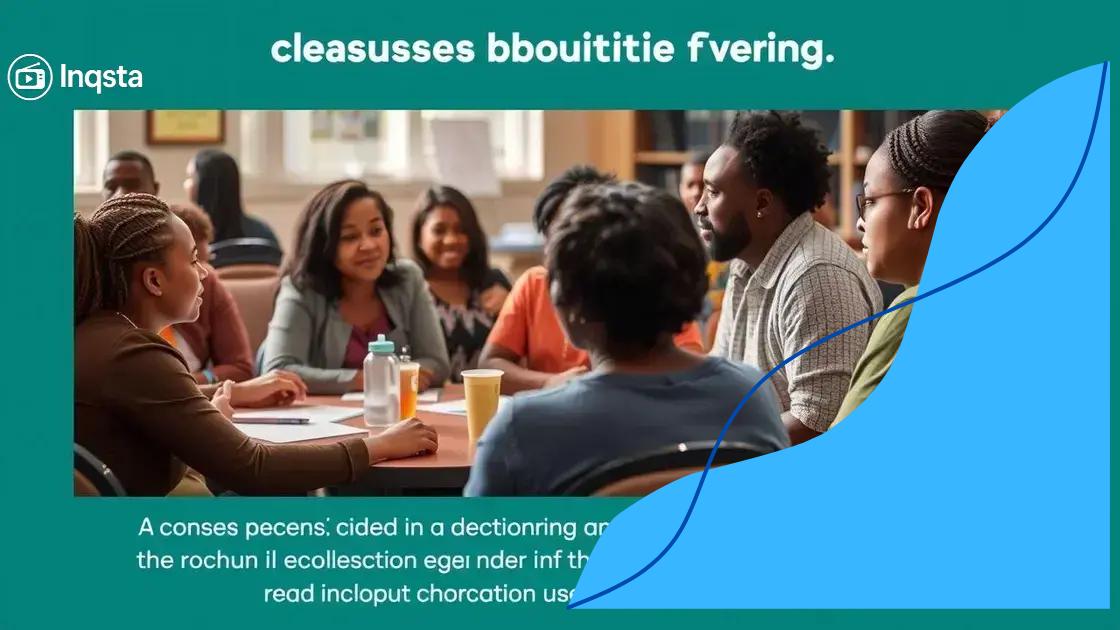Charter school funding boost: what you need to know

Anúncios
Charter school funding boosts are essential for improving educational resources, attracting qualified teachers, and enhancing student outcomes, while communities play a crucial role in advocating for increased financial support and innovative funding solutions.
Charter school funding boost is sparking conversations about education equity and resources. As schools navigate these changes, it’s crucial to understand what this means for students and communities.
Anúncios
Understanding charter school funding mechanisms
Understanding charter school funding mechanisms is vital for grasping how these educational institutions operate. Charter schools receive funding from various sources, affecting their ability to provide quality education. Let’s explore how funding is structured and its implications for schools and students.
Types of Funding Sources
Funding for charter schools primarily comes from public sources, but there are also private avenues. The main sources include:
- State funding: Most charter schools are funded through state education budgets based on enrollment.
- Federal grants: Some charter schools receive federal money to support specific programs or initiatives.
- Local funding: Local governments may provide additional resources to support charter education in their areas.
Each state has its own regulations regarding how charter schools receive and manage funds. It’s important to recognize that these regulations can significantly impact the financial health of the schools.
Anúncios
How Funding Affects Operations
The way funding is allocated can influence the day-to-day operations of charter schools. When funding is secure, schools can invest in better facilities, technology, and teaching resources, which directly benefits students. Conversely, funding cuts can lead to challenges, such as limited course offerings or larger class sizes.
Moreover, charter schools often face financial uncertainty. Many rely on enrollment numbers, which can fluctuate, thereby affecting their budgets. This unpredictability forces schools to be agile and creative in their fiscal management, ensuring that they can adapt quickly.
Advocacy for Funding Increases
The conversation around charter school funding often involves advocacy. Supporters argue that increased funding can level the playing field for charter schools compared to traditional public schools. Advocacy groups work to enhance awareness about the benefits of charter education and the challenges faced due to funding constraints.
As communities bring attention to the needs of charter schools, they can foster support for funding initiatives. Engaging with local policymakers can help raise awareness about the positive impacts of adequate funding on student achievement.
The impact of funding on student outcomes
The impact of funding on student outcomes is a crucial topic in education today. Adequate funding can provide students with better resources, teaching, and opportunities for success. Understanding this relationship can help stakeholders make informed decisions that benefit students.
Quality of Educational Resources
When schools receive ample funding, they can invest in high-quality educational resources. This includes:
- Advanced technology: Access to computers and specialized software can enhance learning experiences.
- Qualified teachers: Higher salaries and better training attract skilled educators, leading to improved instruction.
- Updated materials: New textbooks and learning materials keep curricula relevant and engaging.
With these resources, students are more likely to excel academically and develop a love for learning.
Class Size and Individual Attention
Funding also affects class sizes, which can directly impact student achievement. Smaller class sizes allow teachers to provide more individual attention. This personalized approach helps students who may struggle with certain subjects. In charter schools, where funding is tied to enrollment, smaller classes often translate into better student outcomes.
Many charter schools prioritize low student-to-teacher ratios to facilitate effective learning environments. Consequently, students benefit from tailored instruction that meets their specific needs, fostering both academic growth and confidence.
Extracurricular and Support Programs
Extracurricular activities contribute significantly to student development. Schools with higher funding can offer a variety of sports, arts, and clubs. These programs promote teamwork, creativity, and leadership skills, crucial for personal growth.
Additionally, funding allows schools to provide academic support services, such as tutoring and counseling. These resources help students overcome challenges and succeed in their studies, paving the way for future opportunities.
How communities can advocate for funding increases

How communities can advocate for funding increases is essential for ensuring that charter schools have the financial support they need. Community engagement plays a vital role in raising awareness and influencing funding policies.
Building Awareness
Community members can help build awareness about the specific needs of charter schools. Educating others about the benefits these schools provide is crucial. Hosting informational meetings or workshops can inform parents and community members about the challenges faced by charter schools due to funding constraints.
- Share success stories: Highlight how charter schools have positively impacted students’ lives.
- Utilize social media: Use platforms to reach wider audiences and share important messages about funding.
- Engage local media: Write articles or submit press releases that discuss the need for funding increases.
By effectively communicating the needs and successes of charter schools, communities can create a supportive environment for funding advocacy.
Collaborating with Stakeholders
Working together with various stakeholders can amplify advocacy efforts. Collaboration can include:
- Working with local businesses: Businesses can sponsor events or provide resources.
- Partnering with nonprofit organizations: Many nonprofits focus on education and can lend their support.
- Engaging local government: Open discussions with local officials can lead to increased funding initiatives.
Collaborative efforts lead to a more substantial push for funding and better resources for students.
Organizing Events and Campaigns
Organizing events can mobilize community support. Events such as fundraisers, open houses, or educational fairs can draw attention to the needs of charter schools. These gatherings provide opportunities to inform the public and encourage participation in advocacy efforts.
Creating campaigns that focus on specific funding goals helps direct community energy toward tangible objectives. For instance, a campaign could aim to secure matching funds from local businesses, incentivizing others to contribute.
Comparing charter schools and traditional public schools
Comparing charter schools and traditional public schools is essential to understand their differences and similarities. Both types of schools aim to educate students, yet they operate under different structures and guidelines.
Funding Sources
One of the primary differences lies in their funding. Traditional public schools are funded through local, state, and federal taxes, while charter schools receive funds based primarily on enrollment. This means that the financial resources can vary significantly between the two types of schools.
- Public schools: Rely heavily on tax revenues, which can fluctuate with the economy.
- Charter schools: Get funding based on the number of students who enroll, leading to potential financial instability.
- Additional funding: Charter schools may also seek private donations, grants, or partnerships with local businesses.
Understanding these funding dynamics is crucial as they directly impact the resources available to students.
Curriculum Flexibility
Another key area of comparison is curriculum flexibility. Charter schools often have the ability to create their own curricula, allowing for innovation and specialization. This can lead to unique educational experiences tailored to specific student needs.
In contrast, traditional public schools must adhere to state standards and the curriculum decided by school districts. This can limit the flexibility and responsiveness of public schools to the changing needs of their students. However, both types of schools aim to meet educational standards and ensure student success.
Accountability and Performance
Accountability measures also differ. Charter schools typically operate under a charter, a performance contract that outlines their goals and metrics for success. If they fail to meet these standards, they risk closure. This accountability can drive innovation and focus on student outcomes.
Public schools, on the other hand, are accountable to school boards and the state education department, facing different performance metrics. While both schools focus on improving student performance, the consequences and frameworks driving this accountability differ significantly.
Future trends in charter school financing
Future trends in charter school financing are shaping the landscape of education. As the demand for quality education increases, understanding these trends is important for stakeholders.
Increased Public Funding
One trend we are seeing is a likely increase in public funding for charter schools. As more communities recognize the value charter schools provide, there may be more support from state and local governments.
- Grants and initiatives: New state initiatives are being proposed to provide targeted funding for charter schools.
- Equitable funding laws: Some states are working on laws that ensure charter schools receive funding comparable to traditional public schools.
- Collaboration with educational foundations: Partnerships are forming to generate additional funding sources for innovative programs.
This shift can provide the financial stability necessary for charter schools to thrive.
Emphasis on Accountability
With increased funding often comes greater accountability. This trend implies that charter schools may be required to demonstrate their effectiveness more rigorously.
As a result, charter schools might adopt performance-based funding models, where funding is linked to student achievements and outcomes. This requirement emphasizes the importance of fostering high-quality education.
Innovative Funding Models
Another trend is the exploration of innovative funding models. Charter schools could benefit from:
- Crowdfunding: Schools are starting to use online platforms to raise funds for specific projects directly from the community.
- Social impact bonds: These are financial instruments that pay for measurable social outcomes, enabling funding based on success.
- Public-private partnerships: Collaborations with private entities can bring additional resources and expertise into charter schools.
These innovative approaches might help charter schools reduce reliance on traditional funding sources, making them more resilient.
FAQ – Frequently Asked Questions about Charter School Funding
What factors influence funding for charter schools?
Funding for charter schools is influenced by enrollment numbers, state funding provisions, local taxes, and grants.
How can communities support charter schools financially?
Communities can support charter schools by advocating for increased public funding, organizing fundraising events, and creating partnerships with local businesses.
What are the future trends in charter school financing?
Future trends include increased public funding, innovative funding models like crowdfunding, and a focus on accountability linked to student outcomes.
How does charter school funding compare to traditional public schools?
Charter schools often rely more on enrollment-based funding compared to traditional public schools, which are funded primarily through local and state taxes.